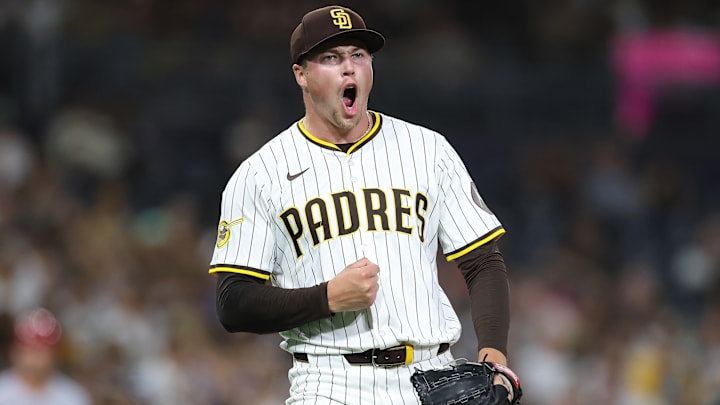The Padres’ offseason started with a jolt, and not just because of Mike Shildt’s sudden retirement. On a Zoom call with reporters on Oct. 14, president of baseball operations AJ Preller made it clear that virtually every pillar of San Diego’s 2026 plan is under review, right down to the ninth inning. The subtext was impossible to miss: Mason Miller, the most electric arm on the roster, may not be locked into one job. In a winter where the Padres must rebuild their dugout leadership and reframe their pitching blueprint, Miller’s usage has become a bellwether for how aggressive (or flexible) this front office intends to be.
That’s why Preller’s tone mattered. Rather than rubber-stamping Miller as the automatic closer after a late-season takeover, he acknowledged the organization is still weighing roles and will huddle with the coaching staff, and with Miller himself over the next couple of weeks. It wasn’t a coy non-answer. It was an intentional opening of the door. The Padres need starting innings. They also need to shorten games late. Miller can help in either place, and San Diego is openly exploring which version creates the most total value in 2026.
How a Mason Miller role change could reshape the Padres’ 2026 pitching plan
Preller’s message landed alongside a reminder of recent precedent. The Padres haven’t been shy about rethinking a pitcher’s lane when the upside warrants it, see Drew Pomeranz (stretched back into a starter and turned into an All-Star in 2016), Seth Lugo (reliever-to-rotation success in 2023), and Michael King (built up from multi-inning relief into a starter). That track record, and the scarcity of top-end starters on the market is why the “starter” conversation for Miller isn’t just talk. Even in a tiny sample, he struck out 26.7% of hitters across six career starts, evidence that his triple-digit fastball and wipeout breaker can play multiple times through a lineup when pitch counts and recovery windows are managed.
Of course, there’s an equally compelling argument to leave him right where he finished: slamming doors. If Robert Suarez departs or the club reallocates late-inning responsibilities, a Miller-anchored ninth simplifies everything behind a still-forming rotation. A locked-in closer clarifies leverage for the rest of the bullpen, lets the front office target specific matchup arms, and preserves Miller’s availability across a 162-game marathon. You can also cap workload without capping impact; 65–70 high-leverage innings from Miller might swing as many wins as 120 innings with strict five-and-dive guardrails.
104 MPH 🔥
— MLB (@MLB) October 1, 2025
Mason Miller is bringing the heat pitching on back-to-back days! #Postseason pic.twitter.com/S6TyC8G3iB
So what would a starter path actually look like? The most realistic version is a phased build: a spring ramp aimed at four-inning, 60–70 pitch starts in April/May, with a mid-season pivot if the health calculus changes or if the bullpen springs leaks. A hybrid “bulk-out” role is also on the table, pairing Miller for 3–4 innings with a piggyback to dodge third-time penalties while maximizing his two elite pitches. Any of these options require early clarity with the player, because training, between-appearance routines, and strength plans diverge sharply by role.
A rotation move boosts Miller’s arbitration case in 2027 and beyond
The stakes are bigger than one job title. Choosing Miller’s lane forces the Padres to declare their identity on the mound. If they push him toward the rotation, they’re signaling confidence in internal leverage options and a belief that a top-end run-prevention unit starts with length. If they keep him closing, they’re betting on run suppression through suffocation, shortening games and winning the seventh through ninth. Either way, Preller’s openness wasn’t hedging; it was strategy. The right answer is the one that creates the most total outs across the season — and the most tough outs in October.
There’s also a dollars-and-years layer here. Arbitration still values traditional, role-driven benchmarks. If Miller returns to starting by 2026, his platform stats heading into 2027 and beyond, innings, starts, quality starts, wins, ERA, and any awards votes — become the comps that drive his raises. Starters generally have a higher arbitration ceiling than relievers because of workload-based counting stats and award pathways.
Elite closers can cash in on 30–40 save seasons, but a durable starter with 150–170+ innings and run prevention to match typically moves up the salary ladder faster. Translation: a shift back to the rotation could add meaningful millions across his arb years (2027 and onward), especially if he stacks volume and votes, whereas staying in the ninth ties him more tightly to saves, games finished, and leverage usage for his case.
The Padres aren’t treating Miller as a fixed asset; they’re treating him as a force multiplier. By leaving the door open now, Preller buys the flexibility to shape the rest of the staff around him, not the other way around.
